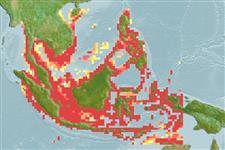Environment: milieu / climate zone / Tiefenbereich / distribution range
Ökologie
seewasser riff-verbunden; tiefenbereich 5 - 50 m (Ref. 90102). Tropical; 20°N - 12°S, 97°E - 135°E (Ref. 3810)
Western Central Pacific: Philippines, South China Sea, Singapore, and Indonesia.
Size / Gewicht / Alter
Geschlechtsreife: Lm ? range ? - ? cm
Max length : 18.0 cm SL Männchen/unbestimmt; (Ref. 48635); common length : 15.0 cm SL Männchen/unbestimmt; (Ref. 3810)
Rückenflossenstacheln (insgesamt) : 10; Rückenflossenweichstrahlen (insgesamt) : 9; Afterflossenstacheln: 3; Afterflossenweichstrahlen: 7. Head scales reaching forward to between level of anterior margin of eyes and posterior nostrils. Suborbital naked. Lower limb of preopercle naked. Pelvic fins short, not reaching level of anus. Axillary scale present. Color: Pale brownish on back, lower part of body whitish. Presence of two bluish stripes across snout, first from middle of eye to tip of snout, second from upper lip to lower margin of eye. Top of snout dusky.
Body shape (shape guide): fusiform / normal; Cross section: oval.
Found in silty coastal bays to deep muddy habitats offshore. Swims on open substrate adjacent to reefs, usually in small aggregations. Often with large bottom feeders such as stingrays to catch disturbed prey (Ref. 48635). Juveniles found close to reefs. Feeds on small crustaceans. Also taken by bamboo stake trap in Thailand. Used also in fish balls, fried and as duck food. Not much appreciated for food, and low priced.
Life cycle and mating behavior
Geschlechtsreife | Fortpflanzung | Ablaichen | Eier | Fecundity | Larven
Russell, B.C., 1990. FAO Species Catalogue. Vol. 12. Nemipterid fishes of the world. (Threadfin breams, whiptail breams, monocle breams, dwarf monocle breams, and coral breams). Family Nemipteridae. An annotated and illustrated catalogue of nemipterid species known to date. FAO Fish. Synop. 125(12):149p. Rome: FAO. (Ref. 3810)
IUCN Rote Liste Status (Ref. 130435: Version 2025-1)
Bedrohung für Menschen
Harmless
Nutzung durch Menschen
Fischereien: weniger kommerziell
Tools
Zusatzinformationen
Download XML
Internet Quellen
Estimates based on models
Preferred temperature (Ref.
123201): 27.7 - 29.2, mean 28.7 °C (based on 588 cells).
Phylogenetic diversity index (Ref.
82804): PD
50 = 0.5001 [Uniqueness, from 0.5 = low to 2.0 = high].
Bayesian length-weight: a=0.01349 (0.00774 - 0.02350), b=2.98 (2.83 - 3.13), in cm total length, based on LWR estimates for this species & (Sub)family-body (Ref.
93245).
Trophic level (Ref.
69278): 3.5 ±0.50 se; based on food items.
Widerstandsfähigkeit (Ref.
120179): hoch, Verdopplung der Population dauert weniger als 15 Monate. (Preliminary K or Fecundity.).
Fishing Vulnerability (Ref.
59153): Low vulnerability (12 of 100).
🛈
Nutrients (Ref.
124155): Calcium = 75.3 [43.9, 154.2] mg/100g; Iron = 0.729 [0.357, 1.698] mg/100g; Protein = 18.9 [17.0, 20.6] %; Omega3 = 0.163 [0.096, 0.273] g/100g; Selenium = 27.5 [16.4, 49.9] μg/100g; VitaminA = 92.3 [26.3, 276.0] μg/100g; Zinc = 1.46 [1.00, 2.13] mg/100g (wet weight);
